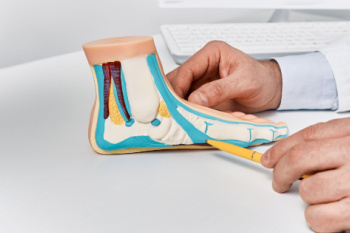January 2025
Main Causes of Pickleball Injuries

The rising popularity of pickleball has resulted in an increase in foot and ankle injuries, particularly among older adults. Quick, repetitive movements such as lunging, running, and sudden foot planting can lead to common injuries like Achilles tendon ruptures, ankle sprains, and fractures. Achilles tendon ruptures are especially prevalent, often requiring immediate medical intervention to restore mobility. Ankle sprains frequently occur when the foot twists or inverts, causing pain, swelling, and instability. Many pickleball injuries are linked to insufficient warm-ups, wearing improper footwear, or the physical demands of the sport, especially on players who may already have underlying foot or ankle issues. A podiatrist can assess these injuries, provide an accurate diagnosis, and determine the best course of treatment. This may include immobilization, bracing, or, in some cases, surgery to ensure a safe recovery and prevent future complications. If you have sustained a foot or ankle injury from playing pickleball, it is suggested that you schedule an appointment with a podiatrist for an exam and treatment.
Ankle and foot injuries are common among athletes and in many sports. They can be caused by several problems and may be potentially serious. If you are feeling pain or think you were injured in a sporting event or when exercising, consult with Milos Tomich, DPM from Dr. Tomich Foot & Ankle Health Center. Our doctor will assess your condition and provide you with quality foot and ankle treatment.
Common Injuries
The most common injuries that occur in sporting activities include:
- Achilles Tendonitis
- Achilles Tendon Rupture
- Ankle Sprains
- Broken Foot
- Plantar Fasciitis
- Stress Fractures
- Turf Toe
Symptoms
Symptoms vary depending upon the injury and in some cases, there may be no symptoms at all. However, in most cases, some form of symptom is experienced. Pain, aching, burning, bruising, tenderness, tightness or stiffness, sensation loss, difficulty moving, and swelling are the most common symptoms.
Treatment
Just as symptoms vary depending upon the injury, so do treatment options. A common treatment method is known as the RICE method. This method involves rest, applying ice, compression and elevating the afflicted foot or ankle. If the injury appears to be more serious, surgery might be required, such as arthroscopic or reconstructive surgery. Lastly, rehabilitation or therapy might be needed to gain full functionality in the afflicted area. Any discomfort experienced by an athlete must be evaluated by a licensed, reputable medical professional.
If you have any questions, please feel free to contact one of our offices located in Milwaukee and Wauwatosa, WI . We offer the newest diagnostic and treatment technologies for all your foot care needs.
When Treatment Is Necessary for Flat Feet

Flat feet, or fallen arches, occur when the arches of the feet flatten causing the entire sole to make contact with the ground. While some people experience no symptoms, others may suffer from foot pain, swelling, or discomfort, especially after standing or walking for long periods. Flat feet can be congenital, develop over time due to aging, injury, or arthritis, or may result from weakened tendons. Treatment becomes necessary if flat feet cause persistent pain, affect mobility, or lead to other complications like knee or back issues. Non-surgical options include wearing supportive footwear, custom orthotics, and targeted stretching exercises. In severe cases, surgical intervention may be required to correct structural damage. If flat feet are interfering with your daily life, it is suggested that you visit a podiatrist for a proper assessment and personalized treatment plan.
Flatfoot is a condition many people suffer from. If you have flat feet, contact Milos Tomich, DPM from Dr. Tomich Foot & Ankle Health Center. Our doctor will treat your foot and ankle needs.
What Are Flat Feet?
Flatfoot is a condition in which the arch of the foot is depressed and the sole of the foot is almost completely in contact with the ground. About 20-30% of the population generally has flat feet because their arches never formed during growth.
Conditions & Problems:
Having flat feet makes it difficult to run or walk because of the stress placed on the ankles.
Alignment – The general alignment of your legs can be disrupted, because the ankles move inward which can cause major discomfort.
Knees – If you have complications with your knees, flat feet can be a contributor to arthritis in that area.
Symptoms
- Pain around the heel or arch area
- Trouble standing on the tip toe
- Swelling around the inside of the ankle
- Flat look to one or both feet
- Having your shoes feel uneven when worn
Treatment
If you are experiencing pain and stress on the foot you may weaken the posterior tibial tendon, which runs around the inside of the ankle.
If you have any questions please feel free to contact one of our offices located in Milwaukee and Wauwatosa, WI . We offer the newest diagnostic and treatment technologies for all your foot and ankle needs.
Plantar Warts Can Be Treated!
What Happens to an Untreated Corn

A corn is a thickened, hardened area of skin that forms on the foot due to pressure or friction. If left untreated, a corn can become painful, inflamed, and prone to infection. The symptoms of an untreated corn typically include tenderness, redness, and swelling surrounding the affected area. Over time, corns may become larger making it difficult to wear shoes comfortably. The main causes of corns include wearing ill-fitting shoes that do not provide enough support, excessive pressure from walking or standing, and abnormal foot mechanics like a misalignment of the toes. Untreated corns can lead to complications such as infections, especially if the skin becomes cracked. Corns can be painful. If you have developed a corn, it is suggested that you schedule an appointment with a podiatrist who can offer appropriate relief and treatment methods.
If you have any concerns regarding your feet and ankles, contact Milos Tomich, DPM of Dr. Tomich Foot & Ankle Health Center. Our doctor will treat your foot and ankle needs.
Corns: What Are They? and How Do You Get Rid of Them?
Corns can be described as areas of the skin that have thickened to the point of becoming painful or irritating. They are often layers and layers of the skin that have become dry and rough, and are normally smaller than calluses.
Ways to Prevent Corns
There are many ways to get rid of painful corns such as wearing:
- Well-fitting socks
- Comfortable shoes that are not tight around your foot
- Shoes that offer support
Treating Corns
Treatment of corns involves removing the dead skin that has built up in the specific area of the foot. Consult with Our doctor to determine the best treatment option for your case of corns.
If you have any questions please feel free to contact one of our offices located in Milwaukee and Wauwatosa, WI . We offer the newest diagnostic and treatment technologies for all your foot and ankle needs.
Risks of Having Bunion Surgery

Bunion surgery can help alleviate discomfort and improve foot alignment, but it is essential to understand the potential risks involved. One concern is the recurrence of the bunion, which may happen if the surgical approach does not address the underlying bone misalignment. Another complication of bunion surgery is stiffness in the big toe joint, often due to scar tissue or pre-existing arthritis, which can limit motion after surgery. Infection, while uncommon, may occur and could involve any hardware used to stabilize the bone. Hallux varus, a rare complication, may cause the big toe to deviate excessively in the opposite direction, potentially leading to pain and further deformity. Also, some patients experience postoperative issues, such as nonunion, where the bone fails to heal properly, often linked to overall health or other factors. A podiatrist can assess your case, recommend the best surgical techniques, and provide expert care during recovery to reduce risks and promote optimal results. If you have a painful bunion, it is suggested that you schedule an appointment with a podiatrist to find out if surgery is an option for you.
Foot surgery is sometimes necessary to treat a foot ailment. To learn more, contact Milos Tomich, DPM of Dr. Tomich Foot & Ankle Health Center. Our doctor will assist you with all of your foot and ankle needs.
When Is Surgery Necessary?
Foot and ankle surgery is generally reserved for cases in which less invasive, conservative procedures have failed to alleviate the problem. Some of the cases in which surgery may be necessary include:
- Removing foot deformities like bunions and bone spurs
- Severe arthritis that has caused bone issues
- Cosmetic reconstruction
What Types of Surgery Are There?
The type of surgery you receive will depend on the nature of the problem you have. Some of the possible surgeries include:
- Bunionectomy for painful bunions
- Surgical fusion for realignment of bones
- Neuropathy decompression surgery to treat nerve damage
Benefits of Surgery
Although surgery is usually a last resort, it can provide more complete pain relief compared to non-surgical methods and may allow you to finally resume full activity.
Surgical techniques have also become increasingly sophisticated. Techniques like endoscopic surgery allow for smaller incisions and faster recovery times.
If you have any questions please feel free to contact one of our offices located in Milwaukee and Wauwatosa, WI . We offer the newest diagnostic and treatment technologies for all your foot and ankle needs.





